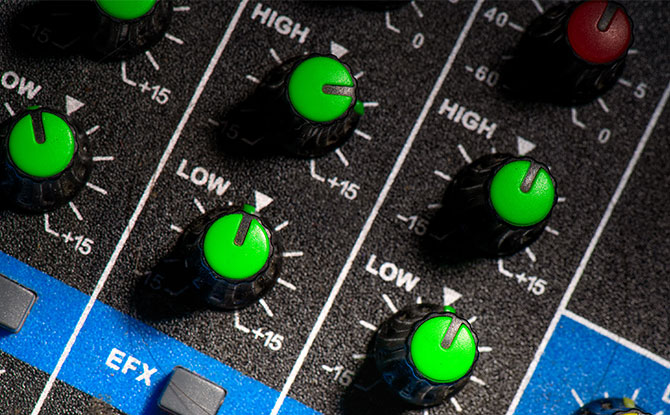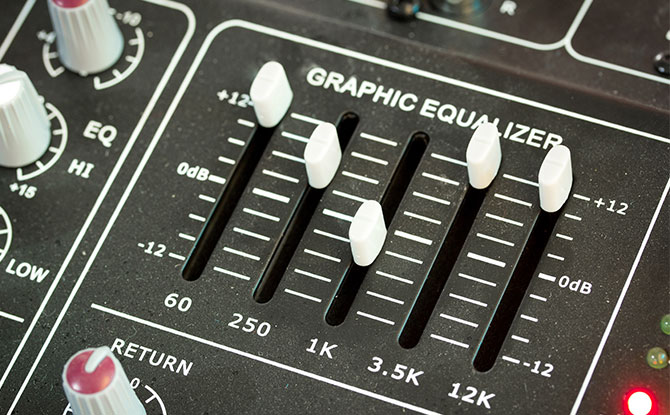Equalizers play a crucial role in audio engineering. These pieces of gear, or software in the case of digital mixers, allow audio engineers to make adjustments to specific frequencies in a sound. There are several types of equalizers that serve various purposes in audio production.
What Does an Equalizer Do?
When it comes to equalization, there are three main parameters that every equalizer works with. These are:
- Frequency
- Gain
- Bandwidth or Q
Frequency determines the center frequency that will be adjusted.
Gain is like a mini volume knob. You can choose to boost the gain on a frequency to make it more prominent or cut the gain to make it less prominent.
Bandwidth or Q is a measure of how many of the surrounding frequencies are impacted when you raise or lower the Gain. A low Q setting results in a wide bandwidth. This means that any adjustments affect a large range of frequencies. A high Q setting result in a narrow bandwidth. This allows you to make more precise adjustments on a frequency.
Type of Equalizers
You can understand different types of equalizers based on how much control you have over these three parameters.
Parametric EQ
Parametric EQs provides the most control for audio engineers as they allow for the adjustment of frequency, gain, and bandwidth (Q).
You will often find them in digital mixers.
One of the advantages of a parametric EQ is its ability to adjust the center frequency, allowing for pinpoint control over problem areas or desired elements in a mix. This allows audio engineers to isolate and shape individual instruments or vocals by boosting or cutting specific frequencies.
Additionally, the gain control enables precise volume adjustments, while the Q control determines the width of the affected frequency range, allowing for narrow or broad shaping of the sound.
In the context of mixing, a parametric EQ is invaluable for achieving clarity, separation, and balance among different elements in a mix. By carefully adjusting the frequency bands, an engineer can carve out space for each instrument or vocal, ensuring that they occupy their own sonic territory without clashing or getting lost in the mix.
Semi-Parametric EQ
In a semi-parametric EQ, the Q is fixed. However, you would still be able to adjust the Frequency and the Gain.
This is useful for zooming in to adjust specific frequencies.
Fixed EQ

This is the simplest form of an EQ. You will sometimes find it labelled Lows, Mids or Highs. With this sort of Fixed EQ, the Frequency and the Q have already been determined. All that you can control is whether to boost or to cut the Gain.
Graphic EQ

This type of EQ uses sliders to control individual frequency bands. A 31-band Graphic EQ will have 31 silders, each controlling a frequency band. It allows for control of the gain, but the Frequency and Q for each of the sliders is fixed.
It has the advantage of letting you “see” or visualise the EQ settings that you are applying.
Graphic EQs are most often used for tuning a room’s acoustics and are an effective tool for removing problem frequencies in live sound engineering. With its intuitive interface, audio engineers can easily identify and attenuate specific frequencies that may cause feedback or muddiness in a venue’s sound system.
It can also often be found as a final EQ for the overall mix coming out from mixer. By manipulating the sliders, engineers can also enhance or attenuate certain frequencies to achieve a desired tonal balance.
Shelving EQ
Shelving equalizers (EQs) allow for adjustments to either the top and bottom range of frequencies. Instead of raising or lowering the frequencies around a notch, the shelving EQ will raise or lower all the frequencies above or below the set frequency.
High Pass Filter
The high pass filter is a special type of EQ that allows frequencies above a certain cutoff point to pass through, helping to remove unwanted low-frequency content in audio productions.
It is commonly used to clean up recordings, improve clarity, and prevent low-frequency rumble or noise from interfering with the overall sound.
When setting the cutoff frequency on a high pass filter, audio engineers typically make adjustments based on the specific requirements of the audio production.
For example, in a music mix, they might choose a higher cutoff point to remove low-frequency elements that could muddy the mix or compete with other elements.
On the other hand, in a podcast or voiceover recording, a lower cutoff point may be used to retain some warmth in the voice while still removing any low-frequency background noise.
One important consideration when using a high pass filter is the slope or steepness of the filter.
A steeper slope will result in a more pronounced roll-off of frequencies below the cutoff point, effectively removing more low-frequency content. However, a steeper slope may also introduce phase shift or affect the overall tonal balance of the audio. It is crucial for audio engineers to listen carefully and make adjustments accordingly to achieve the desired result.
Low Pass Filter
The low pass filter is the reverse of the high pass filter. It allows frequencies below a certain cutoff point to pass through, helping to remove unwanted high-frequency content in audio productions.
Frequencies above the cutoff point are attenuated or rolled off.
Conclusion
Familiarizing oneself with the different types of equalizers discussed in this article is essential for audio engineers to optimize their workflow and achieve the desired sound.
Equalizers are essential tools in audio engineering that allow for precise control over frequencies in a sound spectrum. There are various types of equalizers, each serving specific purposes in audio production.
To learn more about equalization, listen to our various EQ examples.

